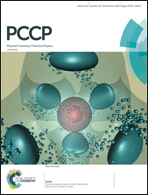Fragment and cluster ions from gaseous and condensed pyridine produced under electron impact
Abstract
We report on direct measurement of all major ion-fragments and cluster-ions formed during high-energy electron impact of 2 keV on gaseous and condensed-phase pyridine. The ion-fragments of the parent pyridine cation are discussed in groups according to the number of atoms from the aromatic ring. The ion yield distributions within these groups show significant shifts towards higher masses for condensed pyridine compared to gaseous pyridine due to hydrogen migration. A wide spectrum of desorbed hydrogenated fragment-ions and ionic clusters with masses up to 320 u are observed for pyridine. The ion yields for the protonated parent molecule (C5H5NH+), the dehydrogenated dimer (C10H9N2+) and the dehydrogenated trimer (C15H12N3+) depend on the mass of the desorbing ionic clusters. The strongest cluster signals are assigned to binding between the parent cation and subunits of the pyridine molecule. Quantum-chemical calculations reveal that the formation of a bond between the pyridine molecules and a carbenium ion is crucial for the stability of selected cluster ions.



 Please wait while we load your content...
Please wait while we load your content...